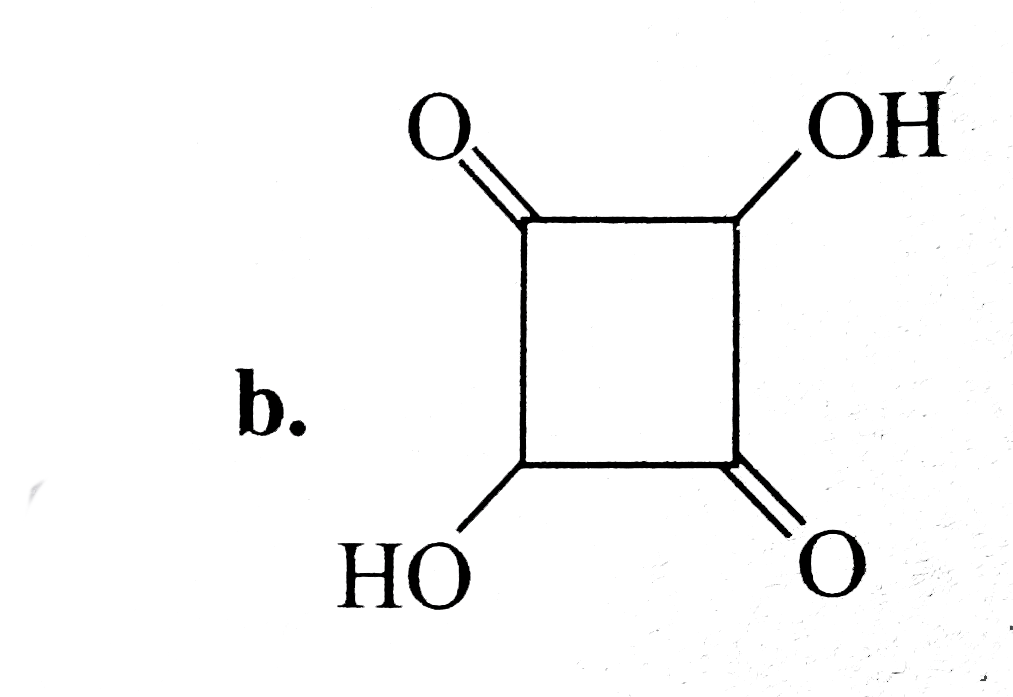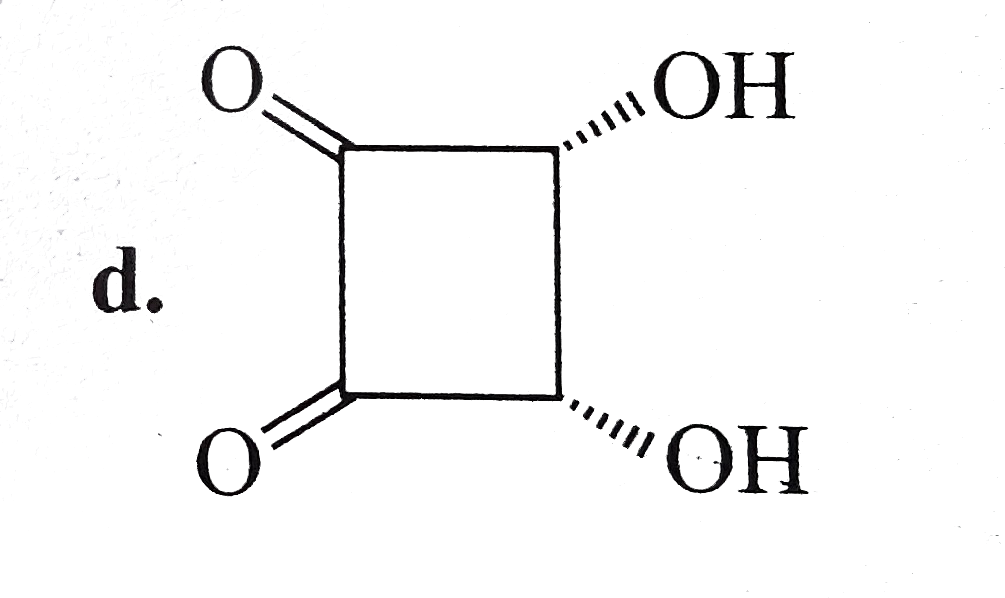Conpound (A)2molof−−−−−−→HIO42 mol of glyoxalic acid.
The compound (A) is:
a.
b.
c.
d.
The correct Answer is:D
To determine the compound (A) that reacts with 2 moles of periodic acid (HIO₄) to produce 2 moles of glyoxylic acid, we can follow these steps:
1. Identify the Product Structure:
Glyoxylic acid has the structure of an aldehyde and a carboxylic acid on a two-carbon chain. Its chemical formula is C₂H₂O₃.
2. Understanding the Reaction:
The reaction with periodic acid typically involves the cleavage of vicinal diols (two hydroxyl groups on adjacent carbons) to yield carbonyl compounds. Since we are producing 2 moles of glyoxylic acid, we need to consider what compound could yield this upon oxidation.
3. Construct the Precursor:
To produce 2 moles of glyoxylic acid, we can start with a compound that has two hydroxyl groups on adjacent carbons (a vicinal diol). Therefore, we can visualize a compound that has the following structure:
- Two carbon atoms, each with a hydroxyl group (OH).
- The structure can be represented as HO-CH(OH)-C(=O)-C(=O)-OH.
4. Remove Hydroxyl Groups:
If we consider removing one hydroxyl group from each carbon, we can visualize that we will be left with a compound that has a four-membered ring structure. This compound will have two carbonyl groups (C=O) and two hydroxyl groups (OH).
5. Final Structure of Compound (A):
The final structure of compound (A) will be a cyclic compound where the two hydroxyl groups are positioned cis to each other. This is crucial because the reaction with periodic acid requires the hydroxyl groups to be in the same direction (cis) for the reaction to proceed correctly.
6. Identify the Correct Compound:
Among the options provided, we need to select the compound that has the correct arrangement of hydroxyl groups (cis) and matches the structure we deduced. The correct compound (A) will be option D, which has the hydroxyl groups in the same direction.
Conclusion:
The compound (A) that reacts with 2 moles of periodic acid to yield 2 moles of glyoxylic acid is option D.
---
Glyoxylic acid has the structure of an aldehyde and a carboxylic acid on a two-carbon chain. Its chemical formula is C₂H₂O₃.
The reaction with periodic acid typically involves the cleavage of vicinal diols (two hydroxyl groups on adjacent carbons) to yield carbonyl compounds. Since we are producing 2 moles of glyoxylic acid, we need to consider what compound could yield this upon oxidation.
To produce 2 moles of glyoxylic acid, we can start with a compound that has two hydroxyl groups on adjacent carbons (a vicinal diol). Therefore, we can visualize a compound that has the following structure:
- Two carbon atoms, each with a hydroxyl group (OH).
- The structure can be represented as HO-CH(OH)-C(=O)-C(=O)-OH.
If we consider removing one hydroxyl group from each carbon, we can visualize that we will be left with a compound that has a four-membered ring structure. This compound will have two carbonyl groups (C=O) and two hydroxyl groups (OH).
The final structure of compound (A) will be a cyclic compound where the two hydroxyl groups are positioned cis to each other. This is crucial because the reaction with periodic acid requires the hydroxyl groups to be in the same direction (cis) for the reaction to proceed correctly.
Among the options provided, we need to select the compound that has the correct arrangement of hydroxyl groups (cis) and matches the structure we deduced. The correct compound (A) will be option D, which has the hydroxyl groups in the same direction.
The compound (A) that reacts with 2 moles of periodic acid to yield 2 moles of glyoxylic acid is option D.
Topper's Solved these Questions
- REDUCTION AND OXIDATION REACTION OF ORGANIC COMPOUNDSBOOK - CENGAGE CHEMISTRY ENGLISHCHAPTER - REDUCTION AND OXIDATION REACTION OF ORGANIC COMPOUNDSEXERCISE - Exercise (Assertion And Reasoning)
10 Videos
- REDUCTION AND OXIDATION REACTION OF ORGANIC COMPOUNDSBOOK - CENGAGE CHEMISTRY ENGLISHCHAPTER - REDUCTION AND OXIDATION REACTION OF ORGANIC COMPOUNDSEXERCISE - Exercise Archives (Subjective)
26 Videos
- REDUCTION AND OXIDATION REACTION OF ORGANIC COMPOUNDSBOOK - CENGAGE CHEMISTRY ENGLISHCHAPTER - REDUCTION AND OXIDATION REACTION OF ORGANIC COMPOUNDSEXERCISE - Exercise (Multiple Correct)
35 Videos
- QUALITATIVE INORGANIC SALT ANALYSISBOOK - CENGAGE CHEMISTRY ENGLISHCHAPTER - QUALITATIVE INORGANIC SALT ANALYSISEXERCISE - Viva Voce Questions And Part-C (Analysis Of Cations)
42 Videos
- SOLID STATEBOOK - CENGAGE CHEMISTRY ENGLISHCHAPTER - SOLID STATEEXERCISE - Ex 1.2 (Objective)
9 Videos
Similar Questions
Compound (A)1molof−−−−−−→HIO4

The compound (A) is:
View SolutionEt−N⊕≡CɵCl2+DMSO−−−−−−−−−−→orHgOorO3. The compound (A) is:
View SolutionFour isomeric optically active compounds NaHCO3−−−−−→CO2(g)(A,B,C,D)(C4H8O3)
Compound (A)LAH−−→(E) (Archiral compound)
Compound (B)KMnO4−−−−−→orCrO3 Inert to oxidation.
Compound (C)−−−−−−−−→NaOI/H3O⊕CHI3(Yellowppt.)+Compound(F).
Compound (C) is :
View SolutionFour isomeric optically active compounds NaHCO3−−−−−→CO2(g)(A,B,C,D)(C4H8O3)
Compound (A)LAH−−→(E) (Archiral compound)
Compound (B)KMnO4−−−−−→orCrO3 Inert to oxidation.
Compound (C)−−−−−−−−→NaOI/H3O⊕CHI3(Yellowppt.)+Compound(F).
Compound (D) is :
View SolutionFour isomeric optically active compounds NaHCO3−−−−−→CO2(g)(A,B,C,D)(C4H8O3)
Compound (A)LAH−−→(E) (Archiral compound)
Compound (B)KMnO4−−−−−→orCrO3 Inert to oxidation.
Compound (C)−−−−−−−−→NaOI/H3O⊕CHI3(Yellowppt.)+Compound(F).
Compound (B) is :
View SolutionIn the following sequence of reactions, the products (A) to (G) are formed:
i. 2CH4(g)Δ−−−→1773K(A)(g)+B(g)
ii. 4molof(A)Δ−−−−−−−−−−→Ni(CN)4+THF(C)O3/oxid.−−−−−→(D)only
iii. (A)(1)1molofNaNH2−−−−−−−−−−−→(2)C2H5I(E)3molofE−−−−−−→RedhottubeF⏐↓O3/Red.(G)only
Compound D is:
View SolutionIn the following sequence of reactions, the products (A) to (G) are formed:
i. 2CH4(g)Δ−−−→1773K(A)(g)+B(g)
ii. 4molof(A)Δ−−−−−−−−−−→Ni(CN)4+THF(C)O3/oxid.−−−−−→(D)only
iii. (A)(1)1molofNaNH2−−−−−−−−−−−→(2)C2H5I(E)3molofE−−−−−−→RedhottubeF⏐↓O3/Red.(G)only
Compound (E) is
View SolutionIn the following sequence of reactions, the products (A) to (G) are formed:
i. 2CH4(g)Δ−−−→1773K(A)(g)+B(g)
ii. 4molof(A)Δ−−−−−−−−−−→Ni(CN)4+THF(C)O3/oxid.−−−−−→(D)only
iii. (A)(1)1molofNaNH2−−−−−−−−−−−→(2)C2H5I(E)3molofE−−−−−−→RedhottubeF⏐↓O3/Red.(G)only
Compounds (A) and (B), respectively, are:
View SolutionRed precipitate Cu2Cl2←−−−−NH4OHP(C5H8)Ozonolysis−−−−−→2-Methylpropanoic acid + compound (Q) structure of P can be-
View Solution2HC≡CHCH2Cl2−−−−−→+NH4Cl(A)1mol−−→HCl(B)
Compounds (A) and (B) are:
View Solution
